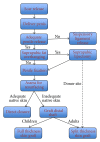Buried penis: evaluation of outcomes in children and adults, modification of a unified treatment algorithm, and review of the literature
- PMID: 24490087
- PMCID: PMC3893803
- DOI: 10.1155/2013/109349
Buried penis: evaluation of outcomes in children and adults, modification of a unified treatment algorithm, and review of the literature
Abstract
Introduction. Buried penis is a difficult condition to manage in children and adults and conveys significant physical and psychological morbidity. Surgery is often declined due to morbid obesity, forcing patients to live in disharmony for years until the desired weight reduction is achieved. No single operative technique fits all. We present our experience and surgical approach resulting in an improved algorithm unifying the treatment of adults and children. Methods. We conducted a retrospective analysis of patients treated for buried penis between 2011 and 2012. All patients underwent penile degloving and basal anchoring. Penile shaft coverage was achieved with skin grafts. Suprapubic lipectomies were performed on adult patients. Results. Nine patients were identified: four children and five obese adults. Average postoperative stay was three days for children and five for adults. Three adults were readmitted with superficial wound problems. One child had minor skin breakdown. All patients were pleased with their outcomes. Conclusion. Buried penis is a complex condition, and treatment should be offered by services able to deal with all aspects of reconstruction. Obesity in itself should not delay surgical intervention. Local and regional awareness is essential to manage expectations in these challenging patients aspiring to both aesthetic and functional outcomes.
Figures





References
-
- Keyes EL. Phimosis-Paraphimosis-Tumors of the Penis. New York, NY, USA: Appleton & Co.; 1919.
-
- Asimakopoulos AD, Iorio B, Vespasiani G, Cervelli V, Spera E. Autologous split-thickness skin graft for penile coverage in the treatment of buried (trapped) penis after radical circumcision. BJU International. 2012;110(4):602–606. - PubMed
-
- Rivas S, Romero R, Parente A, Fanjul M, Angulo JM. Simplification of the surgical treatment of a hidden penis. Actas Urologicas Espanolas. 2011;35(5):310–314. - PubMed
-
- Borsellino A, Spagnoli A, Vallasciani S, Martini L, Ferro F. Surgical approach to concealed penis: technical refinements and outcome. Urology. 2007;69(6):1195–1198. - PubMed
LinkOut - more resources
Full Text Sources
Other Literature Sources
